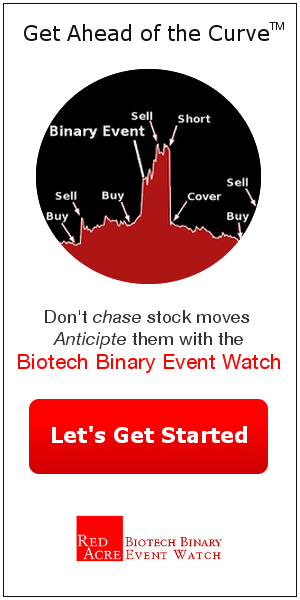Abuse deterrent opioids are a field of great interest to the FDA, doctors and the investment community alike. Pfizer's Remoxy is an abuse deterrent formulation of oxycodone that is licensed from Pain Therapeutics (NASDAQ:PTIE). Remoxy uses the ORADUR abuse deterrence formulation technology from Durect Corporation (NASDAQ:DRRX). We believe that Pfizer may announce a go/no-go decision on Remoxy during their Q1 2013 earnings call scheduled for April 30th. This decision represents a binary event for both DRRX and PTIE and we present here a hedged trading strategy that potentially lets investors participate in the upside from a positive decision while minimizing downside exposure. We've made a Video Red Acre Insight to go over the trade. You can watch the video below or at: http://youtu.be/FZhNGVyNYCo
A Brief History of Remoxy Development
Pain Therapeutics licensed the commercialization rights for certain abuse deterrent formulations of opioids from Durect in 2002. In November 2005, PTIE sub-licensed the commercialization rights for Remoxy and other abuse resistant opioids to King Pharmaceuticals. In June 2008 the Remoxy NDA was submitted to the FDA and was granted priority review; however, in December of that year, PTIE and King received a complete response letter (CRL). In July 2009, after meeting with FDA, PTIE and King announced that they expect a mid-2010 NDA resubmission after collecting 6-month stability data for Remoxy. The Remoxy NDA was resubmitted in December 2010 only to receive another CRL in June 2011. (Note, King Pharmaceuticals was acquired by Pfizer via a tender offer in Q1 2011).
Pfizer has been working on Remoxy since June 2011 by working on slight reformulations as well as conducting bioavailability studies in anticipation of a meeting with FDA in March of this year. Here is how Pfizer has been talking about Remoxy in their quarterly conference calls since 2011.
Q2 2011
Regarding REMOXY, On last quarter's call, I told you we were working for a specific issue in the manufacturing section of the NDA. In June, we announced that we and Pain Therapeutics received a complete response letter from the FDA indicating there are still unresolved issues primarily related to manufacturing. We remain engaged in working through these issues and have been generating additional manufacturing data that will serve as a basis to engage in several discussions with the FDA. We are working diligently towards the satisfactory resolution.
Gregory Gilbert - BofA Merrill Lynch
A couple. First, maybe a little more meat on the bones on the last one. How are you approaching the EP business strategy differently versus in the past? That's for Dave and/or Ian. Secondly, do you still view REMOXY as a when, not an if? And can you offer any timelines around some of the comments you made on that, Ian?
Ian Read - PFE CEO
On REMOXY, we see it as when, not if. We're talking with the FDA. We're bringing Pfizer's manufacturing pharmacy skills to bear on that, and it'll be a question of when.
Q3 2011
For REMOXY and EMBEDA, we are continuing to make progress in the pharmaceutical sciences and manufacturing characterization of those abusive opioid compounds. ... For REMOXY, there are also several key decision points over the next several months that will determine the timing and nature of our response to the FDA's complete response letter.
Q4 2011
on REMOXY, we spent the last few months trying to understand the issue. We have now a much better understanding of the formulation, the manufacturing controls and what we need as analytical test in term of methods. So in addition to that, we will have to conduct 2 bioavailability study that we'll run during the second quarter this year. And when we will have all this data, we think that it will constitute the basis for our engagement with the FDA. And we anticipate meeting with the FDA during the third quarter this year to discuss next step.
Q2 2012
On Remoxy, as we previously stated there, based on the work completed by our technical team over the past several months, we remain cautiously optimistic to be able to bring Remoxy to the marketplace. We have preliminary results from two bioavailability studies that are currently being analyzed along with data from experiments designed to optimize the formulation composition and our analytical methods for that product. And upon completion of those analyses we will determine the timing and the nature or our engagement with the FDA to address the complete response letter that we received in June last year and at this time we are certainly hoping to meet with the FDA in the fourth quarter of 2012.
Q3 2012
If I turn to Remoxy, as you probably know from previous calls, Remoxy has been a challenging asset that our teams have been working on very diligently since the acquisition of King. As a result of that work, the – and extensive insights that we’ve gained around the formulation, we’ve initiated complementary bioavailability studies to assess the pharmakinetic or PK profile of modified Remoxy formulation compositions. And we expect those studies to read out early in 2013. We think that the results of those studies will provide us a much greater clarity on whether or not we’ll be able to adequately address the questions raised in the complete response letter that we received from the FDA.
So we’re targeting a late March meeting with the FDA to discuss those outputs and agree on a net go or no-go decision. I think one last comment just to make is that I think it’s important to remember that our commitment to this area is very strong, and as such we continue to invest in our compound ALO-02, which is an extended release oxycodone, which uses an altraxon platform technology and it’s currently in Phase III.
Clearly from "when not if" in Q2 2011. to "determining the timing and nature" of their response to the FDA, to making a "net go/no-go decision", Pfizer has been walking back expectations about their level of commitment to Remoxy.
Based on the evolving language from PFE, we believe that there is an equally likely chance that Pfizer will elect to scrap the Remoxy program or find a way to go forward.
How PTIE and DRRX Stock Prices Will Respond to the Remoxy Decision
PTIE has no advanced pipeline candidate besides Remoxy. In fact, their other pipeline candidates are also abuse resistant formulations of drugs based on the ORADUR technology. If PFE scraps Remoxy, the implication would be that the rest of PTIE's pipeline is basically worthless. We expect PTIE would trade down to cash value of $1.24 per share on a PFE Remoxy no-go decision.
PTIE could (evetually) trade back to the $9 level if the Remoxy program gets the green light.
DRRX has several other pipeline candidates. On April 16, the company announced that an NDA for Posidur was submitted to the FDA. On a Remoxy no-go decision we expect that DRRX would trade for 2X cash if not higher. DRRX had 28 cents per share of cash as of December 31, 2012, thus we see a price of $0.54 on a no-go decision. Should Remoxy get the green light, DRRX should recover to the $2.30 level initially, and eventually to over $3.
Since DRRX recently closed at $1.31, the potential loss on a negative outcome is approximately $0.77.
A Pain-Free Trade
To capture potential upside while protecting against downside, we recommend the following hedged trade: Long DRRX (cost $1.31) and long PTIE $2.50 May PUTS (asking price 25 cents when we initiated our position).
The PTIE puts should be in the money by $1.25 on a negative decision, resulting in approximately $1 in net downside protection. This means that even if the long DRRX leg of the trade drops as low as $0.31, the trade breaks even.
On the other hand, should PFE decide to go forward with the Remoxy NDA resubmission, we expect that DRRX will eventually move by close to 100%. The hedged trade sacrifices 25 cents of the upside to ensure that the downside does not result in an unacceptable loss.
Potential risks to this trade include a misjudgment of timing. Should PFE not reveal the go-forward plan for Remoxy before May options expiration, the premium paid for the puts is wasted. Furthermore, should PTIE fail to drop to cash value, the extent of downside protection would be diminished.
Conclusion
PFE's Q1 2031 earnings call on April 30th potentially has far ranging implications for both PTIE and DRRX. As outlined above, a hedged trade consisting of long DRRX and long PTIE May $2.5 puts affords a risk-mitigated way to participate in the upside of a positive outcome without undue downside risk.
Update
On April 24th, PTIE issued their Q1 2013 financial update. Cash per share is $1.22 and the company indicates that Pfizer met with FDA on March 28th. PTIE expects to receive written notice from Pfizer regarding the outcome of this meeting "shortly".



